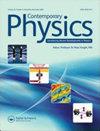业余爱好者的轴子
IF 3.3
4区 物理与天体物理
Q2 PHYSICS, MULTIDISCIPLINARY
引用次数: 0
摘要
摘要分类是理论物理学中一个日益流行的话题,并引发了全球范围内的实验努力。在下文中,我将回顾轴子存在的动机,它们背后的理论,以及寻找轴子的方法。目标读者是有兴趣的业余爱好者、物理学本科生或其他领域的科学家,所以我没有使用复杂的数学或高级理论主题,而是使用了大量的类比。关键词:轴子、暗物质、超辐射、轴子电动力学、强cp问题致谢本文得到了科学技术设施委员会欧内斯特·卢瑟福奖学金(ST/T004037/1)的支持。披露声明作者未报告潜在的利益冲突。在三维空间中,梯度算子为∇,在这种情况下,x是向量叉积。光速为c,普朗克常数为h。粒子质量以电子伏特eV为单位,其中1 eV=1.78×10−36 kg,氢原子的质量约为109 eV。粒子物理学家经常使用的单位是h =c=1,虽然我已经尽力还原了这些因素,以及ϵ0和μ0的因素,但我不能保证我捕捉到了每一个。注1关于GR的进一步阅读,出于实用目的,我推荐Schutz [Citation70]的介绍性书籍,而Misner, Thorne和Wheeler [Citation71]的“第一轨道”包含了大量的思想实验和直觉。对于那些热衷于做研究的人,我喜欢卡罗尔[引文72]我们把重点放在宇宙微波背景的暗物质证据上,因为用其他方式解释宇宙微波背景是不可能的。如果不引入新的暗自由度,也就是不引入dm,那么修改重力就行不通。比例常数可以通过量纲分析来估计。电火花加工的单位电荷乘以距离。我们要处理的电荷是夸克电荷,e/3,距离是中子的大小,10 - 15米。因此,我们估计常数为这些数字的乘积,约3×10−14e m。使用量子场论[Citation73]计算的中子EDM值为d=5×10−14θe m:非常接近我们的朴素估计“轴子”这个名字来源于弗兰克·威尔切克。后来,Weinberg和Wilczek在1977年独立地(发表于1978年)第一次意识到Peccei和Quinn的理论预测了粒子的存在,并计算了它的质量。威尔切克以这种美国清洁剂的名字创造了“轴子”这个词。“轴”来自轴子和夸克之间的左/右相互作用的必要性,物理学家称之为“轴”,而“on”听起来只是一个粒子的名字(想想“玻色子”、“中子”等)。轴子“清理了强cp问题的烂摊子”。温伯格将这种粒子命名为“希格莱特”,因为它有点像希格斯玻色子,只是更轻实际的计算需要一个量子场论的研究生课程。你可以在这些参考文献[Citation76,Citation77]中找到你可以在维基百科上读到Kaluza-Klein理论。在强耦合极限下,弦上的自由度在所谓的m理论和f理论中重组为“涌现的”第11维,甚至是第12“半”维参考文献[Citation78].9,《当代物理学》一篇相关平行主题的文章,使用原子干涉仪搜索超轻标量暗物质一个非常巧合的是,对另一种暗物质候选者——超对称弱相互作用大质量粒子(WIMP)的首次搜索也在今年进行了[Citation79]。WIMP DM产生理论与轴子产生理论一样,在1981年取得重大理论突破后,于1983年得到发展[Citation80,Citation81]。然而,wimp和轴子这两种模型的未来却截然不同,在20世纪90年代和21世纪初,wimp在很大程度上占据了优势。这在一定程度上要归功于技术:WIMP DM的直接搜索迅速提高了灵敏度,而间接搜索则依赖于欧洲核子研究中心的希格斯搜索。直到2010年代及之后,轴子搜索才受到技术和想法的限制。现在,轴子和wimp的命运在很大程度上发生了逆转如果轴子聚集成“小簇”,会有一些微妙之处,但这与ADMX探测的大质量尺度无关,参见参考文献。[引文83 - 87]作者说明david J. E. Marsh在牛津大学获得哲学博士学位,此后曾在圆周研究所、伦敦国王学院和哥廷根大学任职。他目前是Ernest Rutherford研究员和伦敦国王学院理论粒子物理和宇宙学讲师,位于伦敦斯特兰德,WC2R 2LS。本文章由计算机程序翻译,如有差异,请以英文原文为准。
Axions for amateurs
ABSTRACTAxions are an increasingly popular topic in theoretical physics, and are sparking a global experimental effort. In the following I review the motivations for the existence of axions, the theories underlying them, and the methods to search for them. The target audience is an interested amateur, physics undergraduate, or scientist in another field, and so I use no complicated mathematics or advanced theoretical topics, and instead use lots of analogies.KEYWORDS: Axionsdark matterhaloscopesuperradianceaxion electrodynamicsstrong cp problem AcknowledgmentsI am supported by an Ernest Rutherford Fellowship from the Science and Technologies Facilities Council (ST/T004037/1).Disclosure statementNo potential conflict of interest was reported by the author(s).Nomenclature/ notationThe gradient operator in three dimensions is ∇, and in this context × is the vector cross product. The speed of light is c, Planck's constant is h. Particle masses are quoted in units of electronvolts, eV, where 1 eV=1.78×10−36 kg, and an atom of hydrogen is approximately 109 eV. Particle physicists often used units where ℏ=c=1, and while I have tried my best to restore these factors, as well as those of ϵ0 and μ0, I cannot guarantee I caught every one.Notes1 For further reading on GR I recommend the introductory book by Schutz [Citation70] for practical purposes, while the ‘first track’ in Misner, Thorne, and Wheeler [Citation71] contains lots of thought experiments and intuition. For those keen to do research, I enjoy Carroll [Citation72].2 We focused on evidence for DM from the CMB because it is impossible to explain the CMB any other way. Modifying gravity doesn't work without also introducing new dark degrees of freedom, i.e. without introducing DM.3 The constant of proportionality can be estimated by dimensional analysis. An EDM has units charge times distance. The charge we have to play with is the quark charge, e/3, and the distance is the size of the neutron, 10−15 m. So we estimate the constant as the product of these numbers, about 3×10−14e m. The value of the neutron EDM computed using quantum field theory [Citation73] is d=5×10−14θe m: very close to our naive estimate.4 The name ‘axion’ is due to Frank Wilczek. It was Weinberg and Wilczek who, independently later in 1977 (published in 1978) [Citation74,Citation75] first realised that Peccei and Quinn's theory predicted the existence of a particle, and computed its mass. Wilczek coined the phrase ‘axion’ after the American detergent. The ‘axi’ comes from the left/right-handed necessity of the interaction between axions and quarks, which physicists call ‘axial’, while the ‘on’ just sounds like a particle name (think ‘boson’, ‘neutron’ etc.). The axion ‘cleans up the mess’ of the strong-CP problem. Weinberg's name for the particle was the ‘Higglet’, since it is a bit like a Higgs boson, only lighter.5 The actual computation requires a graduate course in quantum field theory. You can find it in these references [Citation76,Citation77].6 You can read about Kaluza–Klein theory on Wikipedia.7 In the weakly coupled limit. In the strong coupling limit, degrees of freedom on the strings reorganise themselves into an ‘emergent’ 11th dimension or even a 12th ‘half’ dimension in so-called M-theory and F-theory.8 For a Contemporary Physics article on related and parallel topic, the use of atom interferometers to search for ultralight scalar dark matter, see Ref. [Citation78].9 In a remarkable coincidence, some of the first searches for another dark matter candidate, the supersymmetric weakly interacting massive particle (WIMP), were also carried out in this year [Citation79]. The theory of WIMP DM production, like that of axions, was also developed in 1983 [Citation80,Citation81], after major theoretical breakthroughs in 1981 [Citation82]. The futures of these two models, WIMPs and axions, were very different though, with WIMPs very much in the ascendancy throughout the 1990s and early 2000s. This was due, in part, to technology: WIMP DM direct searches developed sensitivity rapidly, and indirect searches piggybacked off the Higgs search at Cern. Axion searches were much more limited by technology, and ideas, until the 2010s and later. Now, the fortunes of axions and WIMPs have largely reversed.10 There are some subtleties if the axion clumps into ‘miniclusters’, but this is not expected to be relevant at the mass scale probed by ADMX, see Refs. [Citation83–87]Additional informationNotes on contributorsDavid J. E. MarshDavid J. E. Marsh obtained his DPhil from the University of Oxford, and has since held posts at Perimeter Institute, King's College London, and University of Goettingen. He is currently an Ernest Rutherford Fellow and Lecturer in Theoretical Particle Physics and Cosmology at King's College London, Strand, London, WC2R 2LS.
求助全文
通过发布文献求助,成功后即可免费获取论文全文。
去求助
来源期刊

Contemporary Physics
物理-物理:综合
CiteScore
2.90
自引率
5.00%
发文量
18
审稿时长
>12 weeks
期刊介绍:
Contemporary Physics presents authoritative and lucid introductory review articles on important recent developments in physics. The articles are specially commissioned from experts in their field. The authors aim to review comprehensively the current state of their subject and place it within a broader context of contemporary research, industrial possibilities and applications in an accessible way.
The Journal is of particular use to undergraduates, teachers and lecturers and those starting postgraduate studies who wish to be introduced to a new area. Readers should be able to understand the review without reference to other material, although authors provide a full set of references so that those who wish to explore further can do so. The reviews can also be profitably read by all those who wish to keep abreast of the fields outside their own, or who need an accessible introduction to a new area.
Articles are written for a wide range of readers, whether they be physicists, physical scientists or engineers employed in higher education, teaching, industry or government.
Contemporary Physics also contains a major section devoted to standard book reviews and essay reviews which review books in the context of the general aspects of a field.
 求助内容:
求助内容: 应助结果提醒方式:
应助结果提醒方式:


